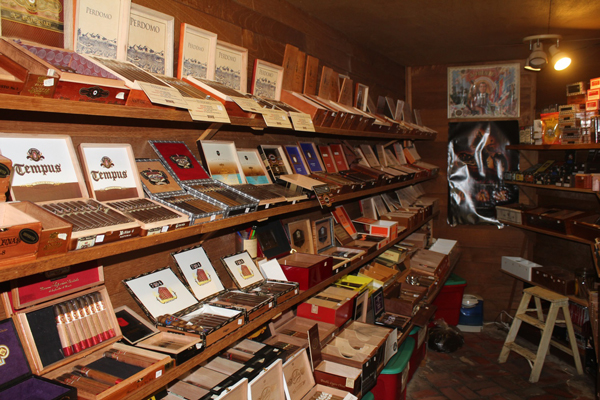“We concentrate more on family companies because we want to support those people who support the industry,” Sarah says. “That sort of separates us from the other retailers in the area. We’re different enough, and it works out well for us. We attract a different kind of clientele too. We get college kids, blue-collar guys and millionaires. They all feel at home here because we do our best to make them feel special when they come inside the store.”
While Bayou Tobacco’s cigar offerings may set it apart from other stores in the area, its pipe and pipe tobacco inventory is another area that separates the store from local competitors. Mike is the pipe guy. He enjoyed his first pipe in 1973, and he still almost always has a pipe with him. He’s likely forgotten more about the pipe and
pipe tobacco world than most people will ever know.
 “I will smoke an occasional cigar, but I love pipes,” Mike says. “I can tell what the tobacco is just by tasting it. There is always a variety of tastes. Some guys want me to blog about it, but I don’t want to do that. There are a few aromatics that I still smoke, but for the most part I don’t. I ask customers if they want a natural sweet or if they want a flavored tobacco and then go on from there.”
“I will smoke an occasional cigar, but I love pipes,” Mike says. “I can tell what the tobacco is just by tasting it. There is always a variety of tastes. Some guys want me to blog about it, but I don’t want to do that. There are a few aromatics that I still smoke, but for the most part I don’t. I ask customers if they want a natural sweet or if they want a flavored tobacco and then go on from there.”
Because of Mike’s interest and deep knowledge of pipes and pipe tobaccos,
the categories make up approximately 40 percent of Bayou Tobacco’s annual sales. The store stocks new pipes by Ser Jacopo, Nording, Savinelli, Dunhill, Neerup, Mastro de Paja, Gepetto, Rossi, Paykoc, Tim West, Jobey, Brebbia, La Rocca, Eric Stokkebye’s 4th Generation and Missouri Meerschaum. It also has dozens of estate pipes available for sale.
“I try to start everyone off at about $35 for their first pipe,” Mike says. “They don’t want to spend a lot of money, and if that’s too much for them then I suggest a corncob pipe. Our most popular price range is $150. That seems to be the sweet spot for our pipe buyers.”
Pipe tobaccos include bulk and tins of Mac Baren, Newminster, Lane, Altadis, McClelland and Stokkebye, as well as Bayou Tobacco’s own blends, which could be rendered unsalable if the lawsuit asking for an injunction against the Food and Drug Administration’s (FDA) regulation of the premium tobacco industry
is unsuccessful.
“We make our own blends using a lot of the bulk,” Mike explains. “For the most part that’s what sells. We sell more black Cavendish as part of our own blends than any other tobacco. We have until Dec. 31 to register with the FDA as a manufacturer. We’re trying to find a way to prove that these blends existed before the Feb. 15, 2007, predicate date. If we can’t, we might consider going through the substantial equivalency process with our best-selling blends. It’s really important for the industry that the lawsuit asking for the injunction against the FDA succeed. Our future depends on it.”
If the lawsuit fails and FDA plans remain unchanged, it would be a huge expense to pay the money necessary to undergo that process to continue blending those tobaccos and legally selling them. Growing government regulation and higher taxes are just a reality for tobacconists these days. Sarah, who is president of the Louisiana Independent Tobacconists Association, sometimes tires of the fight but knows it must continue if her business is to survive.

“I would love to spend all day selling tobacco and talking to people who come into the store, but we have to fight in politics today,” she says. “I try not to look a few years down the road. I know it’s probably not good business, but I like to go with the flow and be where I feel like I’m supposed to be. I get cocky and plan ahead and God changes those plans. We do what needs to be done to keep the business that has lasted 47 years going. I have the personality to say what I think and do the things that I need to do to get things to happen the way I think they should, so I think it will work out in the end.”
The Committee wouldn’t have it any other way.
This story first appeared in the September/October 2016 issue of Tobacconist magazine.
– Contributed by Stephen A. Ross







